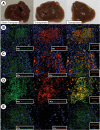A murine model demonstrating reversal of structural and functional correlates of cirrhosis with progenitor cell transplantation
- PMID: 31659188
- PMCID: PMC6817879
- DOI: 10.1038/s41598-019-51189-7
A murine model demonstrating reversal of structural and functional correlates of cirrhosis with progenitor cell transplantation
Abstract
Development of cell transplantation for treating liver cirrhosis hinges critically on the availability of animal models for studying human stem cell transplantation. We report an immune-permissive murine model of liver cirrhosis with full clinical correlates of decompensated liver disease, and allows testing efficacy of stem cell transplantation. Liver cirrhosis was induced in Nod-scid gamma(NSG) mice with oral thioacetamide(TA) and compared to controls over 12 months. 4 month TA treated cirrhotic mice were then transplanted intrasplenically with 2million human fetal liver progenitor cells(HFH) and compared with cirrhotic controls 2 months after transplantation. NSG-TA mice developed shrunken and nodular livers with histological evidence of fibrosis as compared to controls. This was associated with evidence of worsening decompensated liver disease, with jaundice, hypoalbuminemia, coagulopathy, and encephalopathy in NSG-TA mice. Transplantation of HFH resulted in improvement in both fibrosis and markers of decompensated liver disease. We have demonstrated that NSG-TA mice can recapitulate the full clinical picture of structural and functional cirrhosis, both of which can be improved by transplantation of human fetal liver cells. This model serves as a valuable tool for validation of in vivo liver stem cell transplantation and opens up opportunities for studying the mechanism how stem cells reverse fibrosis.
Conflict of interest statement
The authors declare no competing interests.
Figures







References
Publication types
MeSH terms
LinkOut - more resources
Full Text Sources
Medical

